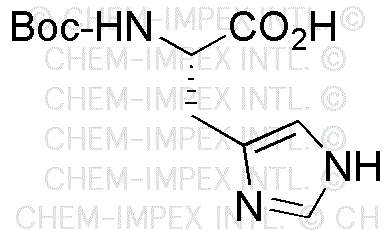Boc-L-histidine is widely utilized in research focused on:
- Peptide Synthesis: This compound serves as a key building block in the synthesis of peptides, particularly those that require histidine residues for biological activity. Its protective Boc group allows for selective reactions, enhancing the efficiency of peptide assembly.
- Drug Development: In pharmaceutical research, Boc-L-histidine is used to create histidine-containing compounds that can act as potential drug candidates, especially in the development of treatments for conditions like cancer and metabolic disorders.
- Bioconjugation: The compound is valuable in bioconjugation processes, where it can be attached to biomolecules such as antibodies or enzymes, improving their stability and functionality for diagnostic and therapeutic applications.
- Protein Engineering: Researchers utilize Boc-L-histidine in the design of modified proteins that require specific histidine interactions, which can enhance enzyme activity or alter binding properties in various industrial applications.
- Analytical Chemistry: It is also employed in analytical methods, such as chromatography, to help separate and identify histidine derivatives, providing insights into protein structure and function.
General Information
Properties
Safety and Regulations
Applications
Boc-L-histidine is widely utilized in research focused on:
- Peptide Synthesis: This compound serves as a key building block in the synthesis of peptides, particularly those that require histidine residues for biological activity. Its protective Boc group allows for selective reactions, enhancing the efficiency of peptide assembly.
- Drug Development: In pharmaceutical research, Boc-L-histidine is used to create histidine-containing compounds that can act as potential drug candidates, especially in the development of treatments for conditions like cancer and metabolic disorders.
- Bioconjugation: The compound is valuable in bioconjugation processes, where it can be attached to biomolecules such as antibodies or enzymes, improving their stability and functionality for diagnostic and therapeutic applications.
- Protein Engineering: Researchers utilize Boc-L-histidine in the design of modified proteins that require specific histidine interactions, which can enhance enzyme activity or alter binding properties in various industrial applications.
- Analytical Chemistry: It is also employed in analytical methods, such as chromatography, to help separate and identify histidine derivatives, providing insights into protein structure and function.
Documents
Safety Data Sheets (SDS)
The SDS provides comprehensive safety information on handling, storage, and disposal of the product.
Product Specification (PS)
The PS provides a comprehensive breakdown of the product’s properties, including chemical composition, physical state, purity, and storage requirements. It also details acceptable quality ranges and the product's intended applications.
Certificates of Analysis (COA)
Search for Certificates of Analysis (COA) by entering the products Lot Number. Lot and Batch Numbers can be found on a product’s label following the words ‘Lot’ or ‘Batch’.
*Catalog Number
*Lot Number
Certificates Of Origin (COO)
This COO confirms the country where the product was manufactured, and also details the materials and components used in it and whether it is derived from natural, synthetic, or other specific sources. This certificate may be required for customs, trade, and regulatory compliance.
*Catalog Number
*Lot Number
Safety Data Sheets (SDS)
The SDS provides comprehensive safety information on handling, storage, and disposal of the product.
DownloadProduct Specification (PS)
The PS provides a comprehensive breakdown of the product’s properties, including chemical composition, physical state, purity, and storage requirements. It also details acceptable quality ranges and the product's intended applications.
DownloadCertificates of Analysis (COA)
Search for Certificates of Analysis (COA) by entering the products Lot Number. Lot and Batch Numbers can be found on a product’s label following the words ‘Lot’ or ‘Batch’.
*Catalog Number
*Lot Number
Certificates Of Origin (COO)
This COO confirms the country where the product was manufactured, and also details the materials and components used in it and whether it is derived from natural, synthetic, or other specific sources. This certificate may be required for customs, trade, and regulatory compliance.


